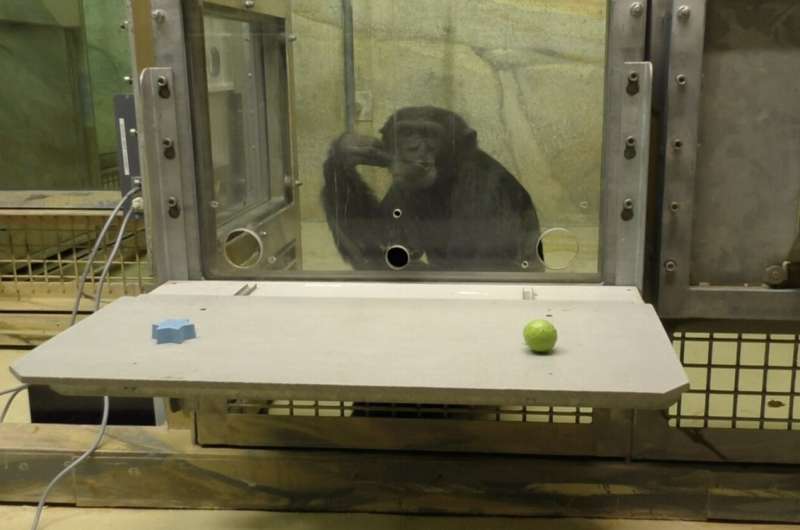Like human children, great apes are inclined to learn from teaching

A new study by researchers from Central European University's (CEU) Department of Cognitive Science, Eotvos Lorand University (ELTE), the University of St. Andrews, and the Max Planck Institute for Evolutionary Anthropology look at whether apes are similar to humans regarding learning capacities when someone is trying to teach them something. The study, "Learning from communication versus observation in great apes," was published on February 21, 2022 in Scientific Reports.
In a world full of complex machines and technical inventions, how do humans acquire the knowledge in a fast and efficient way to become competent users of technical devices? How does a young child, for example, who sees a complex toy for the first time, acquire these skills?
One way to learn is to observe someone using the device and then copy the same action. This method is faster than discovering the device on our own (i.e., in case of a baby, randomly pushing the buttons of the toy to see what happens). However, a better way to learn is when someone actually teaches us or the child how to use the device, while calling attention to the most important actions. (If you push the red button, you will hear music; if you push the red button after the blue button, you will turn on the light.)
Young children of humans show a preference to learn from communication, which is not surprising, as our culture is based on instances of teaching and educational practices. But what about our closest living relatives, the great apes? Primatologists have recorded several cases regarding the ability of great apes to learn from observing others' actions in the wild. However, what apes lack—at least to our current knowledge—is intentional teaching. Juveniles can learn from their mother how to use a wooden stick for termite fishing simply by watching her, but the mother will not try to call the attention of the juvenile to the most important parts of her actions. Does this mean that apes do not care for someone trying to teach them something?
In the study, the researchers showed chimpanzees, bonobos and orangutans how to operate a food dispenser device. In order to get the food, the apes had to insert an object into a small hole on the top of the device. After inserting the object into the hole, the device gave a sound and a food pellet was dispensed at the bottom of the device as a reward. However, while some of the objects were "good objects" because they "made the device work," some objects were "wrong objects" because after inserting them, nothing happened (therefore the ape did not receive a reward).
When the researchers showed the apes how to use the device, they had two types of demonstrators. While one demonstrator was also communicating with the apes before she inserted an object into the device (she made eye-contact, clapped her hand and told the ape "hello"), the other demonstrator did not communicate, only produced some other attention-grabbing sounds (knocked the floor of the room) and then inserted her object into the device. Crucially, the demonstrator who was communicating with the apes only used the "wrong objects," so in these cases, the apes could have learned that these objects will not help them to get the food from the device.
The other demonstrator, however, who was not communicating with the apes used the "good objects," so in these situations, the apes were always rewarded. Finally, at the test phase, the two demonstrators offered their objects to the apes, so that they could chose between them and use the chosen object to operate on the device by themselves. At this point in the research, a surprising thing happened—even though the apes could see with their own eyes that the wrong objects never produced any food for them, they still chose these objects half of the time. This was even more surprising considering that in the control groups, when either both demonstrators were communicating, or none of them were communicating, but one was still using only wrong objects and the other was using the good objects, the majority of the apes did not have any problems with successfully choosing the good objects and got rewarded.
What could be the explanation of these results? "From previous studies we already knew that not only human infants and children are sensitive to communicative cues, but apes can also recognize and react to these cues," says CEU Postdoctoral Fellow and ELTE Assistant Professor Hanna Marno.
"However, while in [the] case of children, we presumed that these cues might be understood by children as 'look, this is the way how you should do it,' in [the] case of apes, it would be surprising to presume such an interpretation, considering that they don't teach each other in the wild. Nevertheless, this study gave evidence that apes could still have some bias to attribute importance for communication, which might be a precursor for teaching in their case. Hopefully, further research will help us understand better what could be the missing capacity they would need in order for them to start to teach each other also in the wild."
More information: Hanna Marno et al, Learning from communication versus observation in great apes, Scientific Reports (2022). DOI: 10.1038/s41598-022-07053-2
Journal information: Scientific Reports
Provided by Central European University



















